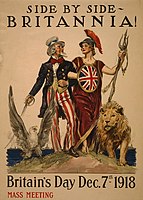Union Jack
The Union Jack,[note 1][3][4] or Union Flag, is the de facto national flag of the United Kingdom. The Union Flag was also used as the official flag of several British colonies and dominions before they adopted their own national flags. The flag continues to have official status in Canada, by parliamentary resolution, where it is known as the Royal Union Flag.[5]
"Union Flag" redirects here. For other uses, see Union flag (disambiguation) and Union Jack (disambiguation).Use
3:5, commonly flown on land; and 1:2, commonly flown at sea.[1]
1606 (origin), 1707 (First version was officially adopted.), 1 January 1801 (current version with St Patrick's Cross)
Blue field on which the Cross of Saint Andrew counterchanged with the Cross of Saint Patrick, over all the Cross of Saint George fimbriated.
It is sometimes asserted that the term Union Jack properly refers only to naval usage, but this assertion was dismissed by the Flag Institute in 2013 after historical investigations.[6][7][8][note 2] The origins of the earlier flag of Great Britain date from 1606. King James VI of Scotland had inherited the English and Irish thrones in 1603 as James I, thereby uniting the crowns of England, Scotland, and Ireland in a personal union, although the three kingdoms remained separate states. On 12 April 1606, a new flag to represent this regal union between England and Scotland was specified in a royal decree, according to which the flag of England, a red cross on a white background, known as St George's Cross, and the flag of Scotland, a white saltire (X-shaped cross, or St Andrew's Cross) on a blue background, would be joined, forming the flag of England and Scotland for maritime purposes.
The present design of the Union Flag dates from a royal proclamation following the union of Great Britain and Ireland in 1801.[10] The flag combines aspects of three older national flags: the red cross of St George for the Kingdom of England, the white saltire of St Andrew for the Kingdom of Scotland and the red saltire of St Patrick to represent Ireland. Although the Republic of Ireland is no longer part of the United Kingdom, Northern Ireland is. There are no symbols representing Wales in the flag, making Wales the only home nation with no direct representation, as at the time of the Laws in Wales Acts 1535 and 1542 (creating legal union with England) the concept of national flags was in its infancy. The Welsh Dragon was, however, adopted as a supporter in the royal coat of arms of England used by the Tudor dynasty from 1485.[11]
The flags of British Overseas Territories, as well as certain sovereign states and regions that were previously British possessions, incorporate the Union Flag into their own flag designs or have official flags that are derived from the Union Jack. Many of these flags are blue or red ensigns with the Union Flag in the canton and defaced with the distinguishing arms of the territory. The governors of British Overseas Territories and the Australian states, as well as the lieutenant governor of Nova Scotia also have personal standards that incorporate the Union Flag in their design.


